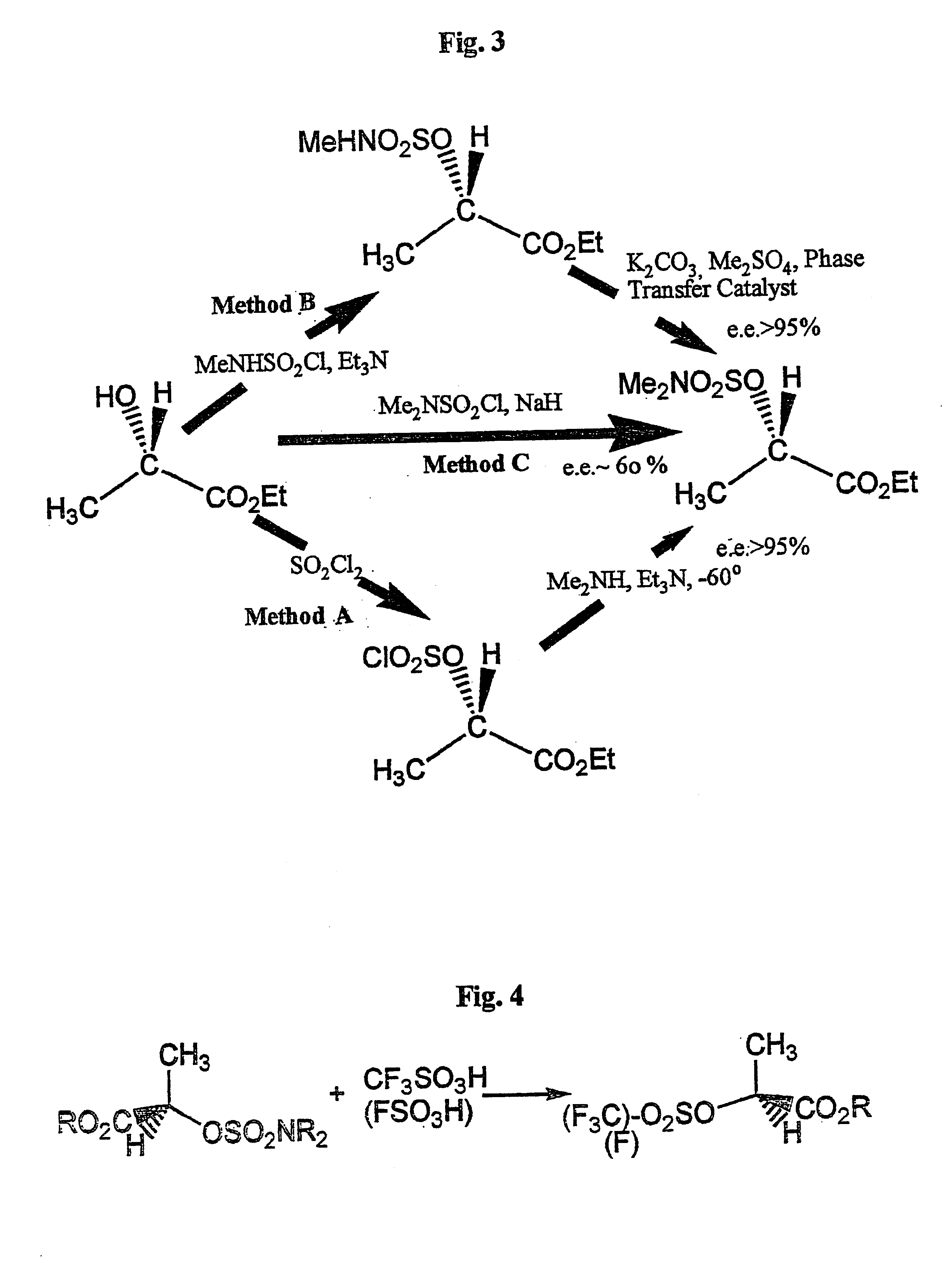Conversion of a hydroxy group in certain alcohols into a fluorosulfonate ester or a trifluoromethylsulfonate ester
a technology of trifluoromethylsulfonate and ester, which is applied in the field of organic chemistry, can solve the problems of high cost of trifluoromethylsulfonic acid, no method is known in the prior art for carrying out such a reaction, and achieve the effect of easy removal
- Summary
- Abstract
- Description
- Claims
- Application Information
AI Technical Summary
Benefits of technology
Problems solved by technology
Method used
Image
Examples
example 1
Method A: Formation of Methyl R-2-O--N,N-dimethyl-sulfamyloxypropanoate
R-Methyl lactate (104 g, 1.00 mole) was added dropwise during 30 min. with stirring at -5.degree. to 0.degree. C. to a mixture of sulfuryl chloride (129 mL) and dichloromethane (130 mL) through which was bubbled a slow stream of dry nitrogen. The mixture was allowed to reach 20.degree. C.sup.- during 8 hrs. (nitrogen bubbling continued) after which all volatiles were removed in vacuo to constant weight at below 30.degree. C., first at 25 mmHg and then at 0.1 mmHg., to leave the colourless and odorless crude chlorosulfonate (164 g, 81%). A portion was distilled at 0.05 mmHg and showed n.m.r.: 1.71 (d, 3H), 3.83(s, 3H, 5.25 (q, 1H).
Of this, 36.0 g (0.178 m) were dissolved in dry dichloromethane (80 mL). A solution of dimethylamine in tert.butyl methyl ether (2.7 molar, 76 mL, 0.205 mole) was admixed with triethylamine (28.4 mL, 0.205 mole) and 4-dimethylaminopyridine (0.5 g) and was added dropwise with stirring dur...
example 2
Method B: Formation of S-Ethyl 2-O--N,N-dimethylsulfamylexypropanoate
(a) To S-ethyl lactate (43.36 mL, 0.38 mole) and triethylamine (55.75 mL, 0.40 mole) in dry dichloromethane (250 mL), N-methylsulfamyl chloride (see Note) (45.65 g, 0.352 mole) was added with stirring, at a temperature below -40.degree. C., during 30 min. Stirring was continued while the white suspension reached room temperature during a period of 8 hrs. Water and dilute HCl was added with stirring, and the organic layer was separated. Drying and solvent removal, finally at 80.degree. C. at 0.5 mmHg gave the crude N-methylsulfamate derivative (73.28 g, 98% of the theoretical amount) which could not be distilled in vacuo without some decomposition.
(b) This material (57.17 g, ca. 0.271 mole) was dissolved in dry acetone (200 mL), dimethyl sulfate (41 mL, ca. 30% excess) and then dry potassium carbonate (42.78 g, ca. 15% excess) were added, followed by addition of 18-Crown-6 (200 mg, ca. 0.3% / mole), and the whole reac...
example 3
Method C: Formation of ethyl S-2-O--N,N-dimethylsulfamyloxypropanoate
To a mixture of S-ethyl lactate (63.5 g, 0.54 mole) and N,N-dimethylsulfamyl chloride (77.5 g, 0.54 m) in dry tert-butyl methyl ether (300 mL), was added sodium hydride (see Note) (11.1 g, 0.4625 mole) was added with mechanical stirring under nitrogen during 6 hrs., using a rotating powder dispenser connected to an electric motor (3-5 revs. / sec.), keeping the mixture all the time at -10.degree. C. -15.degree. C. (ice / salt). Thereafter the mixture was allowed to reach room temperature (18.degree. C.) very gradually during 10 hrs. Water was added, the organic layer separated and the aqueous layer once extracted with dichloromethane, the organic layers dried and the solvents removed in vacuo. The residue was fractionated at 0.1-0.05 mmHg, collecting at first a forerun distilling up to 50.degree. C. containing recovered ethyl lactate and dimethylsulfamyl chloride in a 3:2 molar ratio (by n.m.r.) and thus containing 0.0...
PUM
| Property | Measurement | Unit |
|---|---|---|
| Angle | aaaaa | aaaaa |
| Angle | aaaaa | aaaaa |
| Temperature | aaaaa | aaaaa |
Abstract
Description
Claims
Application Information
 Login to View More
Login to View More - R&D
- Intellectual Property
- Life Sciences
- Materials
- Tech Scout
- Unparalleled Data Quality
- Higher Quality Content
- 60% Fewer Hallucinations
Browse by: Latest US Patents, China's latest patents, Technical Efficacy Thesaurus, Application Domain, Technology Topic, Popular Technical Reports.
© 2025 PatSnap. All rights reserved.Legal|Privacy policy|Modern Slavery Act Transparency Statement|Sitemap|About US| Contact US: help@patsnap.com



